Amaryllis flowers are a type of lily. The name Amaryllis is taken from a shepherdess in Virgil's pastoral "Eclogues", from the Greek ἀμαρύσσω (Latin amarysso) meaning "to sparkle."
For many years there was confusion amongst botanists over the generic names Amaryllis and Hippeastrum, one result of which is that the common name "amaryllis" is mainly used for cultivars of the genus Hippeastrum, widely sold in the winter months for their ability to bloom indoors. Plants of the genus Amaryllis belladonna are known as belladonna lily, naked lady, Amarillo or, in South Africa, March lily.
Amaryllis flower is so beautiful and attractive with a beautiful crown. Amaryllis flowers even more beautiful than the lily. Usually these plants bloom in groups of three or more. These lily-like flowers grow eight to ten inches wide.
The flowers are located on the stalk. Highest Amaryllis can reach two human feet. While the leaves are long like the band grew directly from the bulbs.
Amaryllis flowers have a variety of colors, among others; there are red, white, pink, salmon, and orange. There are also striped and colored mixtures.
Each inflorescence consists of 2-6 flowers that bloom simultaneously. Amaryllis itself is shaped like a trumpet-lipped six.
The plant of the Amaryllis is bulbous, with each bulb being 5–10 cm in diameter. It has several strap-shaped, green leaves, 30–50 cm long and 2–3 cm broad, arranged in two rows.
The leaves are produced in the autumn or early spring in warm climates depending on the onset of rain and eventually die down by late spring.
The bulb is then dormant until late summer. The plant is not frost-tolerant, nor does it do well in tropical environments since they require a dry resting period between leaf growth and flower spike production.
From the dry ground in late summer (August in zone 7) each bulb produces one or two leafless stems 30–60 cm tall, each of which bears a cluster of 2 to 12 funnel-shaped flowers at their tops. Each flower is 6–10 cm diameter with six tepals (three outer sepals, three inner petals, with similar appearance to each other).
The usual color is white with crimson veins, but pink or purple also occur naturally. The common name "naked lady" stems from the plant's pattern of flowering when the foliage has died down.











